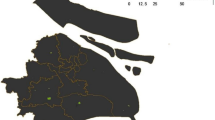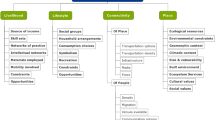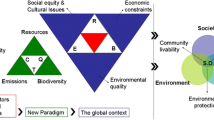Abstract
Understanding the formation process and pattern of production–living–ecological spaces (PLES) is crucial for sustainable land-use management and adaptive city governance. However, previous studies have neglected the symbiotic relationships between land-use functions (LUFs) in identifying and optimizing PLES. To address this gap, this paper proposes a technical framework for assessing PLES from a LUF symbiosis perspective. A case study was conducted in Xiangyang City, China, to identify PLES and analyze its urban–rural differentiation using the symbiosis degree model and landscape pattern indices. Our findings revealed that the symbiotic relationships between LUFs varied. There were 25 combination types of PLES in Xiangyang City, with significantly varied area proportions and spatial distribution. The landscape types and fragmentation of PLES increased along with the gradient change from the old urban area to the rural area. Furthermore, we proposed a PLES optimization strategy involving LUFs symbiosis and the urban–rural gradient. Our study enriches the dimensions of PLES assessment and supports better-coordinated planning and the protection of PLES.








Similar content being viewed by others
Data availability
The datasets used during the current study are available from the corresponding author on reasonable request.
References
Aanen DK, Eggleton P (2017) Symbiogenesis: beyond the endosymbiosis theory? J Theor Biol 434:99–103
Cao J, Zhou WQ, Wang J, Hu XF, Yu WJ, Zheng Z et al (2021) Significant increase in extreme heat events along an urban-rural gradient. Landsc Urban Plan 215:104–210
Carlos IA, María FTA, Frank W, Lutz B (2022) Urbanisation process generates more independently-acting stressors and ecosystem functioning impairment in tropical Andean streams. J Environ Manag 304:114211
Chang GH, Brada JC (2006) The paradox of China’s growing under-urbanization. Econ Syst 30(1):24–40
Cong RG, Ekroos J, Smith HG, Brady MV (2016) Optimizing intermediate ecosystem services in agriculture using rules based on landscape composition and configuration indices. Ecol Econ 128:214–223
Cui JX, Gu J, Sun JW, Luo J (2018) The spatial pattern and evolution characteristics of the production, living and ecological space in Hubei Provence. China Land Sci 32(8):67–73
Deng XZ, Huang JK, Rozelle S, Uchida E (2006) Cultivated land conversion and potential agricultural productivity in China. Land Use Policy 23(4):372–384
Emborg J, Gamborg C (2016) A wild controversy: cooperation and competition among landowners, hunters, and other outdoor recreational land-users in Denmark. Land Use Policy 59:197–206
Fan J, Wang Y, Wang C, Chen T, Jin F, Zhang W et al (2019) Reshaping the sustainable geographical pattern: a major function zoning model and its applications in China. Earth’s Future 7:25–42
Foley JA, Defries R, Asner GP, Barford C, Bonan C, Carpenter SR et al (2005) Global consequences of land use. Science 309(5734):570–574
Hu XF, Zhou WQ, Qian YG, Yu WJ (2017) Urban expansion and local land-cover change both significantly contribute to urban warming, but their relative importance changes over time. Landsc Ecol 32(4):763–780
Ilkwon K, Hyuksoo K, Sunghoon K, Baysok J (2020) Identification of landscape multifunctionality along urban-rural gradient of coastal cities in South Korea. Urban Ecosystems 23(5):1153–1163
Ji ZX, Lu C, Xu YQ, Huang A, Lu LH, Duan YM (2020) Identification and optimal regulation of the production-living-ecological space based on quantitative land use functions. Trans Chinese Soc Agric Eng 36(18):222–231
Jiang MQ, Liu Y (2020) Discussion on the concept definition and spatial boundary classification of “production-living-ecological” space. Urban Dev Stud 27(4):43–48
Jiao GY, Yang XZ, Huang ZQ, Zhang X, Lu L (2021) Evolution characteristics and possible impact factors for the changing pattern and function of “production-living-ecological” space in Wuyuan county. J Nat Resour 36(5):1252–1267
Lan Q, Liu CX, Ling S (2019) Research on measurement of symbiosis degree between national fitness and the sports industry from the perspective of collaborative development. Int J Environ Res Public Health 16(12):21–91
Li YJ, Xie L, Zhang L, Huang LY, Lin Y, Su Y et al (2022) Understanding different cultural ecosystem services: an exploration of rural landscape preferences based on geographic and social media data. J Environ Manag 317:115–487
Li YP, Zhao JS, Zhang SQ, Zhang GR, Zhou LJ (2023) Qualitative-quantitative identification and functional zoning analysis of production-living-ecological space: a case study of urban agglomeration in Central Yunnan, China. Environ Monit Assess 195:1163–1163
Li XC, Zhou YY, Zhao M, Zhao X (2020) Harmonization of DMSP and VIIRS nighttime light data from 1992-2021 at the global scale. figshare. Dataset. https://doi.org/10.6084/m9.figshare.9828827.v7
Liu JL, Liu YS, Li YR (2017) Classification evaluation and spatial-temporal analysis of “production-living-ecological” spaces in China. Acta Geogr Sin 72(7):1290–1304
Liu C, Xu YQ, Huang A, Liu YX, Wang H, Lu LH et al (2018) Spatial identification of land use multifunctionality at grid scale in farming-pastoral area: a case study of Zhangjiakou City, China. Habitat Int 76:48–61
Liu C, Xu YQ, Lu XH, Han J (2021) Trade-offs and driving forces of land use functions in ecologically fragile areas of northern Hebei Province: spatiotemporal analysis. Land Use Policy 104:105–387
Liu C, Cheng L, Li J, Lu XH, Xu YQ, Yang QK (2023) Trade-offs analysis of land use functions in a hilly-mountainous city of northwest Hubei Province: the interactive effects of urbanization and ecological construction. Habitat Int 131:102705
Long HL, Liu YQ, Hou XG, Li TT, Li YR (2014) Effects of land use transitions due to rapid urbanization on ecosystem services: implications for urban planning in the new developing area of China. Habitat Int 44:536–544
Manisha J, Artem K (2022) The concept of planetary urbanization applied to India’s rural to urban transformation. Habitat Int 129:102671
Masoudi M, Tan PY (2019) Multi-year comparison of the effects of spatial pattern of urban green spaces on urban land surface temperature. Landsc Urban Plan 184:44–58
Munzi S, Cruz C, Corrêa A (2019) When the exception becomes the rule: an integrative approach to symbiosis. Sci Total Environ 672:855–861
Pagliarin S (2018) Linking processes and patterns: spatial planning, governance and urban sprawl in the Barcelona and Milan metropolitan regions. Urban Stud 55(16):3650–3668
Pan FJ, Wang HZ, Wang LY (2018) Spatial differentiation of flood regulation service of lakes and reservoirs in Hubei Province. Resour Environ Yangtze Basin 27(8):1891–1900
Peng J, Tian L, Liu YX, Zhao MY, Hu YN, Wu JS (2017) Ecosystem services response to urbanization in metropolitan areas: thresholds identification. Sci Total Environ 607–608:706–714
Qiao WY, Huang XJ (2022) The impact of land urbanization on ecosystem health in the Yangtze River Delta urban agglomerations, China. Cities 130:103–981
Rodríguez-Pose A (2008) The rise of the “city-region” concept and its development policy implications. Eur Plan Stud 16(8):1025–1046
Salhi A, Benabdelouahab S, Bouayad EO, Benabdelouahab T, Larifi I, Mousaoui ME et al (2021) Impacts and social implications of land use-environment conflicts in a typical Mediterranean watershed. Sci Total Environ 764:142853
Shi SS, Kuang WH, Dong SQ (2020) Spatiotemporal pattern of urban-rural gradient land cover changes and their impact on urban heat island in Xi’an City since the 21st Century. Remote Sens Technol Appl 35(03):537–547
Silvana M, Cristina C, Ana C (2019) When the exception becomes the rule: an integrative approach to symbiosis. Sci Total Environ 672:855–861
Sokka L, Lehtoranta S, Nissinen A, Melanen M (2015) Analyzing the environmental benefits of industrial symbiosis: life cycle assessment applied to a finnish forest industry complex. J Ind Ecol 15(1):137–155
Stephan E, Groffman P, Vidon P, Stella JC, Endreny T (2021) Interacting drivers and their tradeoffs for predicting denitrification potential across a strong urban to rural gradient within heterogeneous landscapes. J Environ Manag 294:113021
Sun LQ, Chen J, Li QL, Huang D (2020) Dramatic uneven urbanization of large cities throughout the world in recent decades. Nat Commun 11:5366
Tallis HT, Ricketts T, Guerry AD, Wood SA, Sharp R, Nelson E et al (2011) InVEST 2.2.1 user’s guide. The Natural Capital Project, Stanford, CA
Xia M, Feng XH, Xia JL, Zou W (2021) Delineation of production-living-ecological space in Lishui District of Nanjing based on land multi-functions and suitability. Trans Chinese Soc Agric Eng 37(16):242–250
Xu J, Wu HH, Zhang JH (2022) Innovation research on symbiotic relationship of organization’s tacit knowledge transfer network. Sustainability 14:30–94
Yang YY, Bao WK, Liu YS (2020) Coupling coordination analysis of rural production-living-ecological space in the Beijing-Tianjin-Hebei region. Ecol Indic 117:106–512
Yu SH, Deng W, Xu YX, Zhang X, Xiang HL (2020) Evaluation of the production-living-ecology space function suitability of Pingshan County in the Taihang mountainous area, China. J Mt Sci 17:2562–2576
Zeng R, Zhao R, Liang Y (2018) Cultivated land quality assessment based on AHP-grey correlation analysis method: taking Xiangyang city of Hubei province as an example. Sci Surv Mapp 43(8):90–96
Zhang YN, Long HL, Tu SS, Ge DZ, Ma L, Wang LZ (2019) Spatial identification of land use functions and their tradeoffs/synergies in China: implications for sustainable land management. Ecol Indic 107:105–550
Zhang HT, Wang HW, Lei J, Zhang F, Wang ZW, Tan B et al (2021) Cross-border integration of production-living-ecology function in XPCC and local city based on symbiosis theory. Acta Ecol Sin 41(11):4393–4405
Zhao YQ, Cheng JH, Zhu YG, Zhao YP (2021) Spatiotemporal evolution and regional differences in the production-living-ecological space of the urban agglomeration in the middle reaches of the Yangtze River. Int J Environ Res Public Health 18(23):12–497
Zheng YM, He YR, Zhou Q, Wang HW (2022) Quantitative evaluation of urban expansion using NPP-VIIRS nighttime light and landsat spectral data. Sustain Cities Soc 76:103–338
Zong WW, Cheng L, Xia N, Jiang PH, Wei XY, Zhang FL et al (2018) New technical framework for assessing the spatial pattern of land development in Yunnan province, China: a “production-life-ecology” perspective. Habitat Int 80:28–40
Funding
This research is supported by the National Natural Science Foundation of China (42101282; 42201276); Open Fund of Hubei Key Laboratory of Regional Ecology and Environmental Change (REEC-OF-202304), Research Fund of Institute of State Governance, Shandong University (23C05), Open Fund of Key Laboratory of Coastal Zone Exploitation and Protection, Ministry of Natural Resources (2021CZEPK05), and National College Student Innovation and Entrepreneurship Training Program (S202310511011).
Author information
Authors and Affiliations
Contributions
Chao Liu: conceptualization, methodology, formal analysis, writing—original draft and editing. Qingke Yang: writing—review and polish language. Fenghua Zhou: writing—review and editing, and supervision. Ru Ai: software and editing. Long Cheng: writing—review and polish language.
Corresponding authors
Ethics declarations
Ethical approval
This manuscript does not contain any individual person’s data and ethics approval is not required.
Consent to participate
Written informed consent was obtained from all participants.
Consent for publication
Not applicable.
Conflict of interest
The authors declare no competing interests.
Additional information
Responsible Editor: Philippe Garrigues
Publisher's Note
Springer Nature remains neutral with regard to jurisdictional claims in published maps and institutional affiliations.
Rights and permissions
Springer Nature or its licensor (e.g. a society or other partner) holds exclusive rights to this article under a publishing agreement with the author(s) or other rightsholder(s); author self-archiving of the accepted manuscript version of this article is solely governed by the terms of such publishing agreement and applicable law.
About this article
Cite this article
Liu, C., Yang, Q., Zhou, F. et al. Assessing production–living–ecological spaces and its urban–rural gradients in Xiangyang City, China: insights from land-use function symbiosis. Environ Sci Pollut Res 31, 13688–13705 (2024). https://doi.org/10.1007/s11356-024-31957-3
Received:
Accepted:
Published:
Issue Date:
DOI: https://doi.org/10.1007/s11356-024-31957-3




